![]()
![]()
![]()
Use LEFT and RIGHT arrow keys to navigate between flashcards;
Use UP and DOWN arrow keys to flip the card;
H to show hint;
A reads text to speech;
45 Cards in this Set
- Front
- Back
|
What are cells made up of? |
-Proteins -Carbohydrates -Lipids -Nucleic acid -Water |
|
|
What is the cell theory? |
-It's the basic unit of life for all living organisms. -Cells consists of a substance called protoplasm (living substance of the cell). This includes the nucleus. -All cells are basically similar. -Cells divide to make new cells.
|
|
|
Characteristics of a cell wall: |
-Non-living -Thin and occurs on the outside of the cell membrane. -Mainly consists of cellulose (pectin) fibres which can stretch as the cell grows. -Small openings, the pits, occur here. -Cytoplasmic threads, the plasmadesmata, stretch though the pit. |
|
|
Functions of a cell wall: |
-Protects the living content of the cell. -Gives rigidity to the plant.
|
|
|
Characteristics of a cell membrane: |
-The living outer boundary of the cytoplasm. -Thin and elastic.
|
|
|
Structure of the cell membrane: |
-Consists of a double layer (called bilayer) of phospholipid molecules, with large protein molecules embedded in the phospholipid layer. -Proteins can also occur on the outside. - This theory is known a the fluid mosaic model. -Each phospholipid molecule consists of two parts i.e head and tail *The head (phosphate group) points to the outside and attracts water (hydrophilic) *The tail (two fatty acids) points to the inside and repels water (hydrophobic). -It's not static (it's dynamic) because the phospholipids and proteins can move around (liquid). - The double layer is impermeable to water -soluble molecules such as glucose, amino acids etc -These molecules move through the hydrophobic double layer by means of carrier proteins, which bind to the molecule on the one side and release it on the other side of the membrane. -Some membrane proteins form small canals which only allow ions through. |
|
|
What does the double phospholipid layer look like? |

|
|
|
Functions of the cell membrane: |
-Keep contents of the cell together. -Controls the exchange of substances that pass into the cell and out of the cell. |
|
|
How do cells allow particles to move in and out of the cell? |
-Diffusion -Osmosis -Active transport |
|
|
What is diffusion? |
The movement of any particle from a high concentration to a low concentration. |
|
|
What is osmosis? |
A specialised diffusion of water molecules through a selectively permeable membrane from a high concentration to a low concentration. |
|
|
What is active transport? |
When particles move from a low concentration to a high concentration level. It requires energy. |
|
|
What does a nucleus look like? |
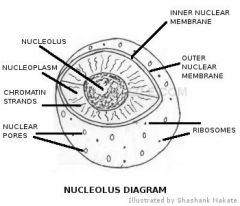
|
|
|
Structure of a nucleus: |
-Nuclear membrane is a double membrane with pores and thus selectively permeable. -Nucleoplasm is a liquid which contains sugars, nucleotides, phosphates and enzymes. -The chromatin network (DNA) is a thread 2 meters long containing genes. -The nucleolus is a small dark body consisting of RNA. |
|
|
Functions of a nucleus: |
-It controls all the metabolic processes of the cell. -The chromatin network contains the hereditary characteristics that are passed to the offspring.
|
|
|
Structure of the plastids: |
-Surrounded by a double membrane. -Found only in the cytoplasm of plant cells. |
|
|
What are the 3 plastids? |
-Chloroplast -Cromoplasts -Leucoplasts |
|
|
Structure of chloroplasts: |
-Oval shapped -Has a double membrane (inner and outer) -The fluid matrix in it is called stroma (stroma contains the enzymes for the dark phase of photosynthesis) -Parallel flattened sacs called thylakoid or lamellae are found in the stroma. -Thylakoids are stacked (stack of coins) to form grana. -Grana are connected to other grana by single thylakoids called intergrana lamellae. -Thylakoids contain a green pigment called chlorophyll and other photosynthetic pigments. Chlorophyll absorbs sunlight sunlight, and the energy of the sunlight is used to make food for the plant in a process known as photosynthesis. -They often contain oil droplets and starch grains, which have been made by photosynthesis. |
|
|
What do chloroplasts look like? |
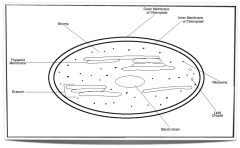
|
|
|
Functions of chloroplasts: |
-Essential for photosynthesis. -During photosynthesis energy rich carbohydrates (glucose) are built up in chlorophyll containing parts of the plant. -The chlorophyll absorbs energy from the sun. -Water and carbon dioxide are required and oxygen is released as a by product. |
|
|
Characteristics of chromoplasts: |
-Plastids that occur in yellow, orange and red flowers, leaves and fruit. -They contain a pigment known as carotenoids. -Chloroplasts change into chromoplasts when fruit ripens, or when autumn leaves change colour. |
|
|
Functions of chromoplasts: |
-Give the yellow, orange, red colour to flowers, leaves and fruit. |
|
|
Characteristics of leucoplasts: |
-Colourless plastids that mainly occur in cells that store food in invisible form. |
|
|
Functions of leucoplasts: |
-They become specialised to store food in the form of starch, lipids or proteins. (when they store starch they are called amyloplasts) -They can change into chloroplasts if exposed to the lights (like potatoes) |
|
|
Structure of a mitochondrion: |
-Cylindrical shaped, hollow rod -Surrounded by a double membrane. *Outer membrane is smooth *Inner membrane is folded to form finger like folds called the cristae which increase the surface area. -Filled with semi-fluid substance, the matrix, that contains the enzymes. -The number of them depend on the energy needed by the cell. |
|
|
Functions of a mitochondrion: |
-Performs cellular respiration (aerobic) -Large amounts of energy are released. |
|
|
What does a mitochondrion look like? |
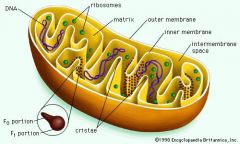
|
|
|
What is cellular respiration? |
The gradual release of energy from carbohydrates using oxygen. Carbon dioxide and water is released. |
|
|
Structure of endoplasmic reticulum (ER): |
-Fine membranous network that connects the nuclear membrane in the cell membrane. -It forms a continuous system of canals throughout the cytoplasm. -ER with ribosome (RER- rough ER) -ER without ribosomes (SER- sooth ER)
|
|
|
Functions of the ER: |
-Provides surface for the attachment of ribosomes. -Transports the ribosomes throughtout the cell using the RER -Synthesises lipids and steroids on the SER (cholestrol) |
|
|
Structure of ribosomes: |
-Small spherical shaped structures that are composed of the RNA and proteins. -Occur: *in the nuclear body *on the ER *in groups in the cytoplasm (polyribosomes)
|
|
|
Functions of ribosomes: |
-Play a role in protein synthesis |
|
|
Structure of vacuoles: |
-Fluid filled cavities which is bounded by a single membrane (selectively permeable) called the tonoplast. -The fluid inside the tonoplast is called cell sap. -Large and prominent in plant cells; small or absent in animal cells.
|
|
|
Functions of the vacuole: |
-Maintain the turgidity of the plant cell. -Contain pigments (anthocyanins) which gives flowers and fruit the blue, violet, purple or dark red colour. -In unicellular animals (amoeba) they control the amount of water in the cell. -For animals like the amoeba they are responsible for food storage and digestion. |
|
|
Structure of lysomes: |
-Vacuoles filled with digestive enzymes. -Only occur in animal cells. |
|
|
Functions of the lysomes: |
-Play a role in food digestion (unicellular animals) |
|
|
Structure of a centrosome: |
-Consists of 2 hollow cylinders, the centrioles, which lie at right angles to each other. |
|
|
Functions of the centrosome: |
-Forms the spindle during cell division. |
|
|
Structure of the golgi apparatus: |
-Consists of stacks of hollow, flat membranes sacs known as cisternae and many vesicles that have broken off the cistrenae. -It occurs in the plant and animal cell near the nucleus. -They are mostly found in secretory cells. |
|
|
Functions of the golgi apparatus: |
-Makes and processes secretions. (saliva, mucus) -Transports proteins from the ER to different parts of the cell. -Vesicles are also used to from lysomes. |
|
|
What does the golgi appartus look like? |

|
|
|
What does the plant cell look like? |
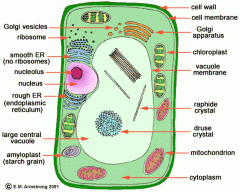
|
|
|
What does the animal cell look like? |
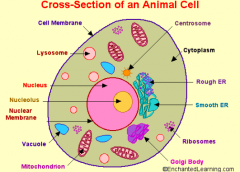
|
|
|
Labels of a plant cell: |
-Cell wall -Cell membrane -Nucleus *nucleolus *nucleoplasm *chromatin network *nuclear membrane -Cytoplasm -Rough ER -Chloroplast -Golgi apparatus -Polyribosomes -Mitochondria -Vacuole *tonoplast *cell sap
|
|
|
Labels of an animal cell: |
-Cell membrane -Golgi apparatus -Cytoplasm -Centrosome -Mitochondria -Nucleus *rough ER *lysome *double-nuclear membrane *nucleoplasm *nucleolus *chromatin network |

